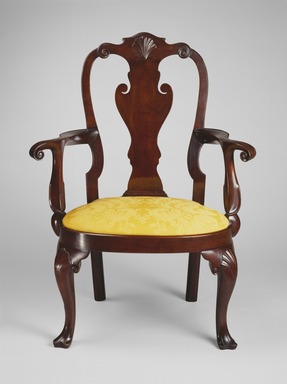Browse

| Accession # | 1997.150.1a-b |
|---|---|
| Maker | William Savery |
| Title | Armchair |
| Date | ca. 1760 |
| Medium | Walnut, yellow pine, modern upholstery |
| Dimensions | 42 1/2 x 31 x 21 in. (107.95 x 78.74 x 53.34 cm) |
| Marks | (1) Incised on top of front seat rail: "I" (2) Paper label attached to outside of rear seat rail: "All sorts of chairs and joiners work made and sold by William Savery. At the sign of the chair a little below the market in Second Street, Philadelphia." (3) Brass plaque attached to inside of rear seat rail: "Fiddle Back Walnut Armchair with Original Label of William Savery, Philadelphia Circa 1750. No. 677 Reifsnyder Collection. American Art Galleries Sale April 27, 1929." [Label added by collector] |
| Credit Line | Matthew Scott Sloan Collection, Gift of Lidie Lane Sloan McBurney |
| Location | Visible Storage: Case 38, Shelf C (18th-Century Furniture) |
| Description | Queen Anne style armchair (a) with slip seat (b). Arched, round-shouldered crest rail with carved central scallop shell flanked by volutes, joining a solid fiddle splat that connects to the seat rail with a molded shoe. Serpentine curved stiles, outlined with beading, ending in reverse-curve back posts. Outward-curving, knuckled arms with scrolled hand rests and cyma-curved arm supports. Horseshoe seat formed from broad, curved front seat rail with applied seat lip, joining two side rails; through tenons of side rails visible on back of stiles. Cabriole legs, with shells carved on the knees, and scroll brackets; legs posted into front rail and terminate in trifid feet. CONDITION - Good. Small dents and scratches, especially on feet and inner proper right arm. |
Curatorial Remarks: These two mahogany chairs—from Mexico and Pennsylvania, respectively—are indebted to the same design source, the Rococo furniture popularized in England by Thomas Chippendale through his seminal furniture pattern book The Gentleman and Cabinet Maker’s Director of 1754. These chairs, and the portraits above, would have been found in formal spaces in the houses of the well-to-do, indicating high social standing. The Philadelphia chair, with its dynamic curves and counter-curves, is a much more expansive interpretation of Chippendale’s style than the more tightly carved and elongated form of the Mexican chair, ultimately reflecting, perhaps, the stricter, hierarchical Spanish American social order.